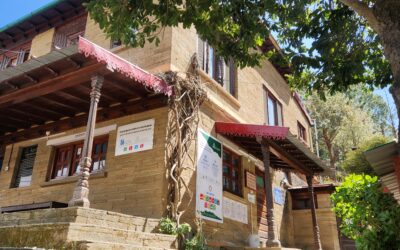It was a hot and humid day, in a Rajasthani Village I visited a few months ago, my first time in this part of the country. Rainy season was beginning and the petrichor reminding me of the full-blown monsoon I had left back home in Mumbai. I was accompanied by two co-fellows, all of us on our first field visit, like a bunch of bright-eyed curious kids. We were here to soak in every experience that came our way.
Our host was a couple in their forties who did everything they could to extend their hospitality. Like every Indian household, they also really believed in the motto, “Feed your guest until they can take no more.” Confused about what meal could be offered to three young girls hailing from distinct regions of the country, the ongoing debate in the family was khichadi v/s puri bhaji, with the votes leaning towards the former. The proceedings of that memorable meal would remain the truth by which I lived the next few months of my life in southern part of rural Rajasthan.
For starters, it took us a while to understand what we were being offered. There was continuous mention of this drink popular with the locals. Old men, young women and children, all relished and savored it. Groups of women were seen carrying earthen pots filled to the brim, from one end of the village to their homes, with what I initially assumed to be water, but later learnt otherwise. Our hosts had a large steel can full of the same white drink occupying a corner of their home. The village was right in the middle of a tribal hamlet. They spoke Rajasthani dialect with a thick Vaghdi accent. Deciphering it’s syllables, we thought the name sounded like – ‘Khatti (sour) sa’.
Earlier that morning, I had spent a few hours visiting the surrounding families when they taught me that they frequently substituted ‘ch’ with ‘s’ and vice versa. Every home I entered, I was asked ‘sa pioge?’ (Will you drink tea?). My logical reasoning had put two and two together. ‘Khatti sa’ now sounded like a weird concoction of sour tea.
Imagine my relief on being corrected. Khatti sa is translated in hindi as Khatti chanch (sour buttermilk). Now, my friends and I eagerly extended our large bowls ready to drain down the hot khichadi with some cool buttermilk. Being true to my South Indian roots, I even placed a special request for the bowl to be topped up. Balancing the bowl, I brought it to my mouth and took a large swig of the drink, having an immediate urge to react like a baby tasting lemon for the first time. A quick glance at my companions and I knew I wasn’t alone. Every sip felt like a concentrate of fermented lemon juice burning my throat. My taste buds were reborn sending my tongue into a spasm, all the while putting up a stoic appearance on the outside. All members in the household barring the three of us took seconds. Out of politeness, I gulped down the large bowl in front of me vowing to stay away from Khatti sa forever.

The drink is prepared like buttermilk except that the curd is kept to set and ferment for 8-10 days before churning it, which gives it the distinct sour taste. In this region, buffalo’s milk is easily available in households as compared to cow’s milk. The locals believe that consuming sour drinks keeps your body cool during the hot and dry summer months when temperatures can be as harsh as 45°C. There is no scientific evidence to back this claim, although the need for body to be continuously replenished with fluids in this climate is undisputed.
During my field visit, I also learnt of a dish called Raab, a porridge of maize, with its signature ingredient as Khatti sa. Raab is relished especially during the winter months after the crop of maize. It is garnished with jeera (cumin) and a bowlful is prepared as a meal for the entire family – adults, children and older people who find it difficult to chew other items. When availability of food is scarce, these flavor packed dishes are a respite.
Fast forward to 8 months into the fellowship, I have had the opportunity to meet the same community more and learn about their lives – joys as well as struggles. I have also had the good fortune to share meals with them. Surprisingly, my taste buds have changed. Just the other day, I found myself returning from the field with a bottle full of Khatti sa and the recipe for Raab. At wedding receptions, I often find myself at the Raab counter taking two servings full instead of Puris. When I think back to the first day, it seems like a lot has changed. Whatever made that happen, I am glad it turned out this way.




0 Comments